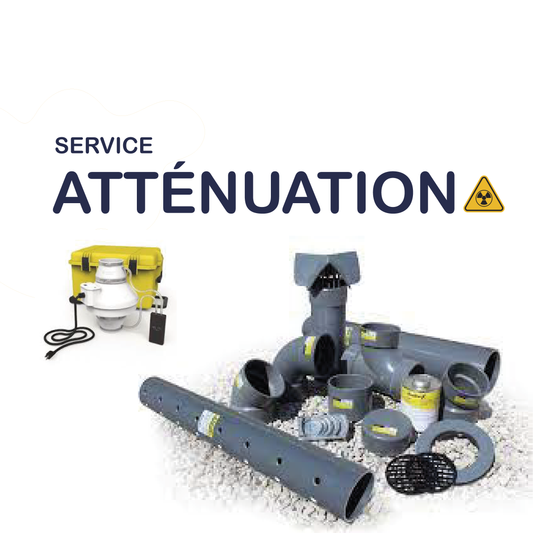Measurement and mitigation
-
Short time measurement
Regular price $49.00 USDRegular priceUnit price per -
Long term radon measurements
Regular price $49.00 USDRegular priceUnit price per -
Short time measurement for real estate transaction
Regular price $112.00 USDRegular priceUnit price per -
Radon gas mitigation services
Regular price $2,088.00 USDRegular priceUnit price per
-

TESTING THE RADON LEVEL
The testing period in your home is a crucial step. Gaz radon Québec specializes in measurement and initially offers a short-term (rapid) or long-term test for your property. The result is available on the day following receipt of the dosimeter at our laboratory.Order a radon test -

MEASUREMENT AND MONITORING
When the measured radon concentrations exceed the Canadian standard of 200 Bq/m3, mitigation measures are required. We are here to help you find and implement the right solution for your home. Gaz radon Québec offers a comprehensive service in the installation of mitigation measures. Appropriate measures can be installed in a single day. A post-mitigation test is included, involving both a rapid and long duration dosimeter. -

Why choose Gaz radon Québec during a real estate transaction?
Gaz radon Québec offers its customers a radon detector with ionization chamber and uses electret, a technology recognized in 30 countries. Delivery of the dosimeter is rapid as are data retrieval and transmission of results. You can plan a test before the pre-purchase inspection and the results can be included in your inspector's report. A clear plus for any buyer concerned about the health and safety of his or her family.Learn more about radon
-

Prevent the negative consequences of radon on real estate transactions by carrying out a preliminary measurement.
Order a testBuying or selling a property is a major step in everyone's life. In this context, measuring the radon level becomes a determining factor. It can reassure the buyer about the safety of the place and increase the value of the property on the market. If the seller has not anticipated this step, the absence of a radon measurement can become a point of negotiation for the buyer.
During the real estate transaction, deadlines are often tight. This makes it difficult to carry out a long-term radon test, which is nevertheless more accurate. Uncertainty about the real level of radon concentration can then set in, hence the importance of anticipating this measurement. Real estate professionals, aware of the issues at stake, are increasingly recommending that sellers and buyers measure the radon level. They understand the crucial importance of this measurement to guarantee the safety of future residents and ensure good understanding during transactions. It is essential to find out more and take the appropriate measures.
-

ACSTR Color System for Visualizing Radon Concentration
Consult the diagramDuring a real estate transaction, the Canadian Association of Radon Scientists and Technologists suggests a rapid radon measurement over 4 days with a device validated by the PNCR-C. The results are available in three color codes:
Green : Radon concentration up to 75 Bq/m³ in winter and 50 Bq/m³ otherwise. Despite a reassuring result, a long-term measurement is recommended at a later date.
Yellow : Concentration between 75 Bq/m³ and 400 Bq/m³, indicating a potential risk. Corrective action and long-term measurement are suggested, as well as a radon reduction system.
Red : Concentration above 400 Bq/m³, requiring intervention. Long-term measurement is recommended, as is the installation of a radon reduction device.
For new owners, a long-term measure of at least 91 days is recommended, carried out by a PNCR-C certified expert, ensuring the safety of residents.
-

The National Building Code of Canada (NBCC) is used for the construction and renovation of buildings in Canada and to promote public health and safety standards.
Code evolutionSome provinces in Canada have adopted additional radon requirements in their building codes. For example, in Ontario, the building code requires that new homes be equipped with a radon reduction system if they are located in an area where radon concentrations exceed a certain threshold. In addition, the National Research Council of Canada has published Guides for Radon Protection in New Homes and Other Buildings, which provide guidance for the design and construction of radon-resistant buildings. These guides can be used by contractors to consider the risk of radon when designing and constructing buildings. In general, it is recommended that buildings be tested for radon to assess risk levels and take appropriate action to protect the health of occupants.
The importance of testing for radon during a real estate transaction
Using Geology to Identify Radon Risk Areas and Inform Prevention and Control Policies: Our Company's Mission
Our company uses mass deployment technology to map radon concentration risks by region. We use advanced geological techniques to identify geographic areas rich in radioactive minerals, which are at higher risk for radon concentrations. We also analyze soil and rock permeability, which can play a significant role in radon concentrations. Using tools such as geological mapping, gamma spectrometry, and geological modeling, we can produce accurate maps that indicate areas at high risk for radon concentrations. These maps can help authorities develop radon prevention and control policies, as well as inform homeowners and property buyers about potential radon risks in their area. With our mass deployment technology, we are able to provide accurate and useful information to protect public health and prevent radon concentrations.








